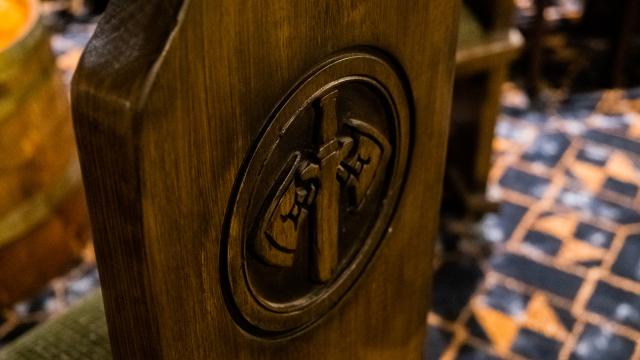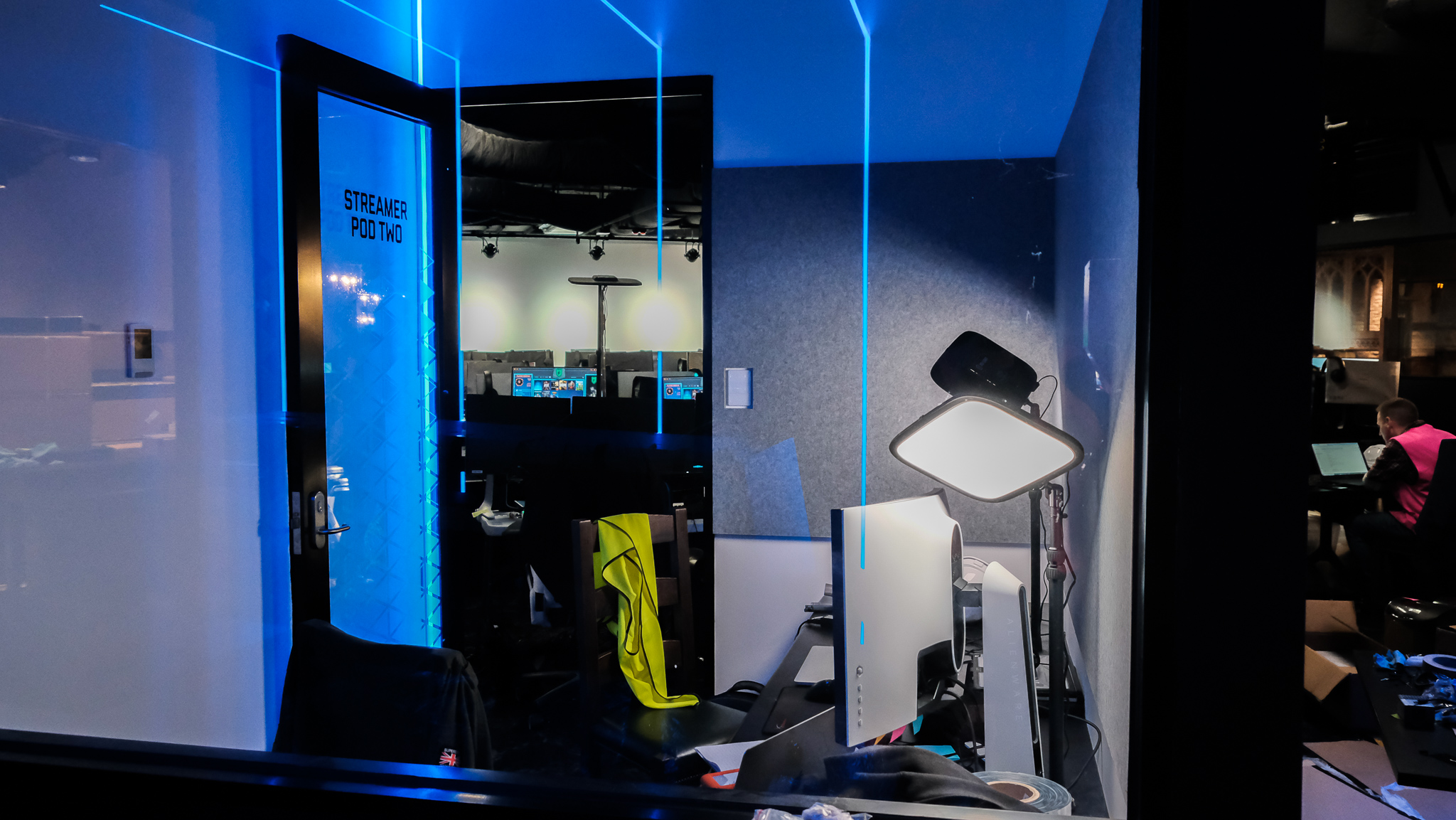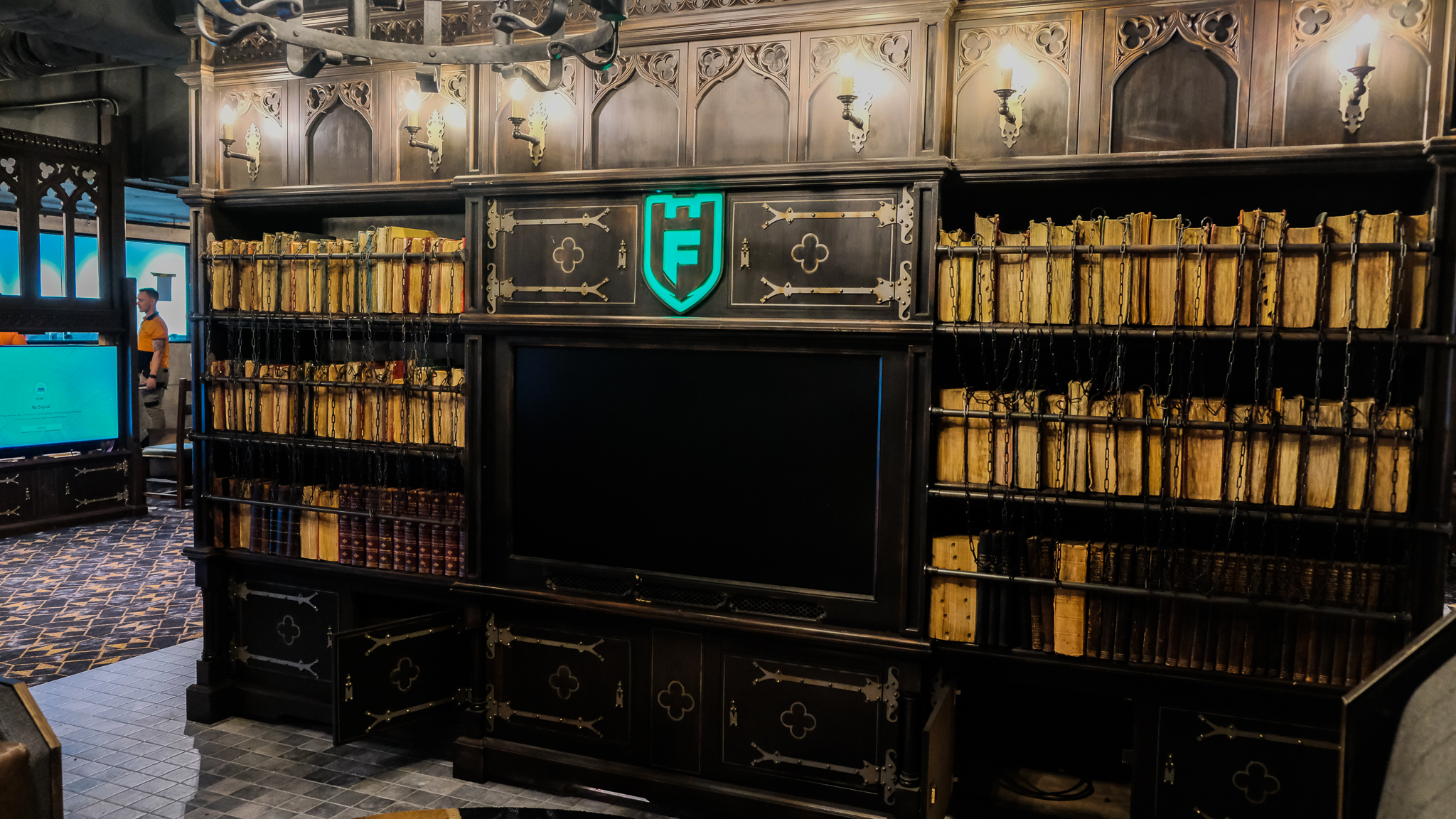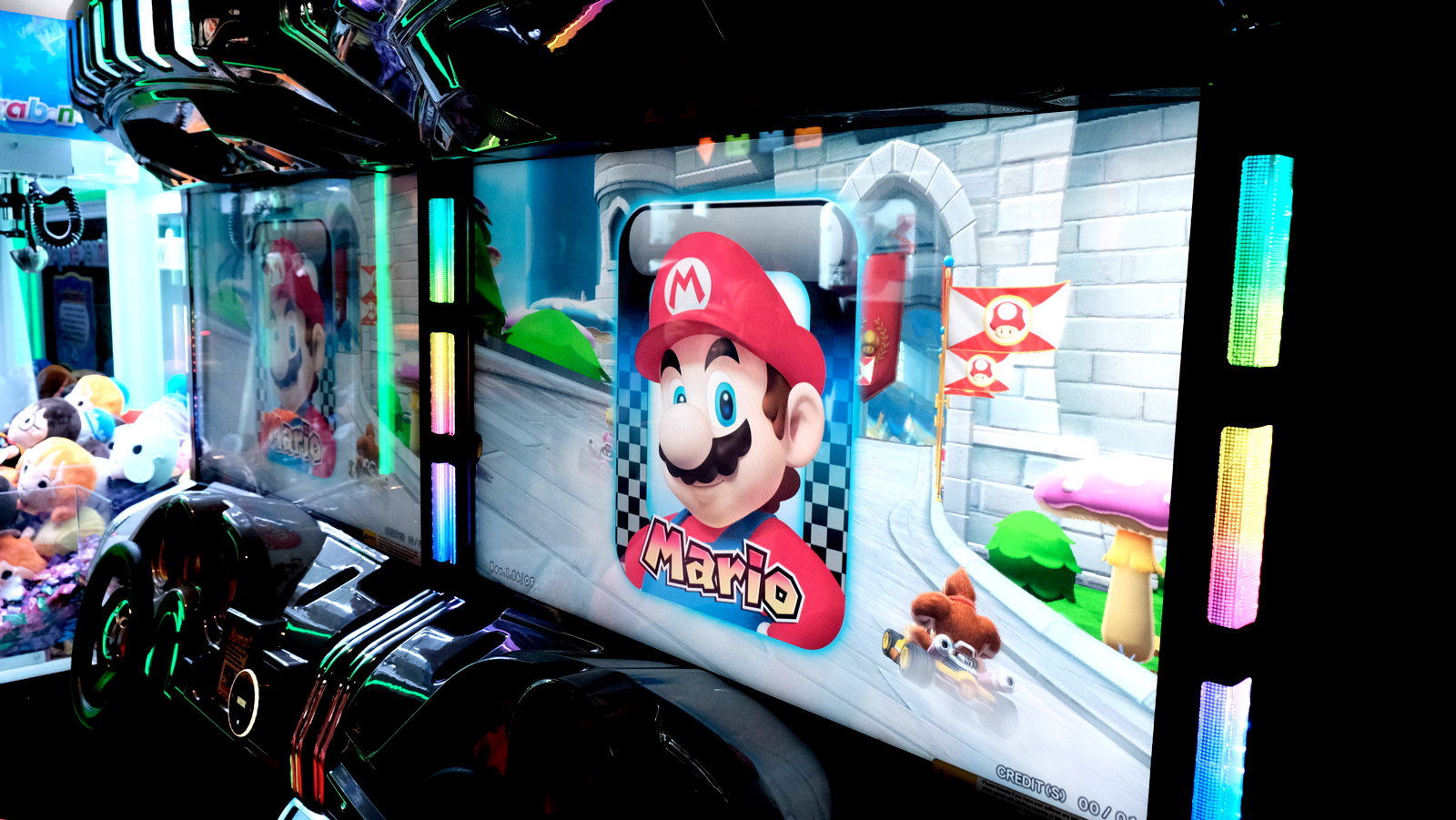2,700 square metres of real estate in Melbourne’s CBD. Inside is a themed restaurant and bar for a few hundred people. Two dedicated PC gaming areas are connected, with arcade machines and a 200-seater esports grandstand. Attached to that is a second bar, full broadcast studio and an esports commentary pit. There’s even a merch store.
Welcome to Fortress Melbourne.
The prospect of a company investing this much money into an Australian gaming venue is mind boggling. It’s something you’d be more likely to see in a country with a stronger internet cafe culture and higher population density.
Just thinking about raising funds to bring all of this together seems insane. So I asked the CEO of Fortress Esports, Jon Satterley, how much it all cost.
Initially, Satterley didn’t respond. But after some pressing, he relented. “It’s in the millions of dollars,” Satterley said, “and not one or two million.”
Even just walking through Fortress Melbourne (located in the Emporium Melbourne luxury shopping centre) ahead of its official opening, I was staggered by the amount of contractors helping out. Giles, Fortress’ co-founder and chairman, said while the business is prepared to spin up or reduce their headcount as necessary, they had 15 or 20 full-timers for “venue staffing” with around 60 people on the books for shorter shifts.
Part of that was just to shell out the venue’s available experience. If someone comes into the Tavern – that’s the name for the Blizzard-esque bar and restaurant in the central part of the lower floor – and they want to play board games, Fortress needs to have someone on call who can explain Catan. If a group wants play on the esports stage on a Tuesday night, someone needs to facilitate that. If someone wants to rent one of the four streaming pods, but they’ve never played around with OBS and they might not even have their own Twitch account, Fortress needs a staffer with streaming experience.
The local industry has always had a certain fascination with Fortress Melbourne, predominately from scepticism. When I originally spoke to the Fortress CEO back at PAX Australia, the company had struggled to secure any interest or support from publishers. Some showed interest, but stopped returning emails. Others wanted to see the venue after it was built. A few representatives from publishers that I spoke to under condition of anonymity weren’t even convinced that construction would finish, let alone the venue actually being successful.
Some of that scepticism has started to fade. “We knew however how many Powerpoint decks and how much bullshit came out of my mouth about what we were doing, the reality of what this is when you’re here, you can see what we’ve done, it’s just so much different to trying to explain it. Just come and have a look and see how we’ve tried to connect the dots for all sorts of gaming passions, and to create that home for all gamers,” Satterley said.
“Increasingly as this has taken shape, [the reaction has been] jaw-dropping amazing.”
So, who exactly is Fortress Melbourne targeting when they talk about all gamers?
The answer is more complicated than you might think. As much as Fortress talks about being a home for gamers, the real aim is to position the venue as an alternative source of entertainment. Most of the pricing has been mapped out against that, with Fortress modelling their pricing against the hourly cost of, say, going to the movies.
“If you think about mainstream entertainment, we might go to the movies or go bowling,” Satterley explained. “We think it ranges around $15 to $20 an hour that people would pay if you go to the movies or a Friday night.”
Fortress doesn’t have a cover charge or a price for entry – something they were very keen to stress. But the actual cost to the consumer isn’t that simple, either.
If you’re just coming in to use one of the regular gaming PCs, a standard Alienware desktop, you’ll have the option of buying a 2 hour pass for $26, or a 4 hour pass for $38. That works out to around $13 or $9 an hour, not including any drinks or food you might buy while you’re there.
For someone who plays more frequently, existing netcafe users who pay a lot less, Fortress has a separate membership program. It’s called the “Power User” and costs $13 a week, with hourly pricing reduced to $4.50 an hour. There’s other perks, like merch (and commemorative merch after six and 12 months), and discounts on meals and beverages. The membership also offers lower pricing for competitions and events and access to a venue-wide leaderboard.
“It’s almost like you’ve joined a club, the Fortress Melbourne club. We’ve gotta be careful that we manage that inventory carefully,” Satterley explained, saying that allowing too many foundational memberships could result in a poor customer experience, since they might not have enough PCs to service everyone.
There is also another membership targeted at tabletop gamers, called the ‘Adventurer’. It’s $13 a week and provides free board game rental — something that is generally free at local game stores. If you’re not a Adventurer member, board game hire costs $10 an hour. Patrons are free to bring their own games into the venue too, and there’s plenty of comfortable seats and tables.
If that’s not enough, there’s a third membership for “Fortress Fanatics”, pitched as a membership for gamers who want to support Australian esports.
The appeal of Fortress is apparent as soon as you walk in. It’s much brighter, roomier and more comfortable than what anyone would expect from a regular internet cafe.
But it’s probably better to think of Fortress as a restaurant and bar with a gaming theme. But it comes with a significant caveat.
Take the large, comfortable booths and ornate wooden tables. In most venues those are just a thing that you get by virtue of showing up early. That’s part of the appeal: get out of work a bit faster, or leave uni a bit quicker, and you’ll have the nicest seats in the house. But in Fortress’s Tavern, those VIP areas will cost at least $160.
“We think that there’ll be people who are just eager to land this and enjoy this with their friends, table service, the whole thing, access to gaming on this screen,” Satterley said. “$160 flat on an off-peak, and then on peak there’s a slightly different pricing tier because it’s an expected food and beverage spend … for our foundational members, off-peak is free any time before 4PM,” Giles explained. Adventurers will also get a discounted $11 hourly rate on the streaming pods, which is a bit confusing given PC gamers are the ones most likely to be interested in livestreaming, not those going to a public space to enjoy board games, tabletop and miniatures with their friends.
Fortunately you don’t have to pay for every seat. Regular tables in the Tavern are completely free.
The food, however, is pretty decently priced. A lot of the fare is pizzas and burgers, which was a deliberate choice. Ramen, karaage chicken and other Japanese-inspired finger food are a good fit for a gaming crowd and a gaming venue, but the Melbourne CBD has plenty of that already. That said, there’s plenty of Asian influences in the pub grub staples: the mushroom burger is on a bright green matcha brioche bun, the grilled chicken burger is beetroot-coloured, and there’s a Vietnamese-inspired loaded fries, based around hoi sin, sriracha, peanuts and coriander.
A lot of the food, though, is stereotypical “gamer” food. There’s only two salad choices on the menu – a garden salad and a chicken Caesar – and all the mains are carb-heavy offerings. In a city with more restaurants and cafes per capita than any city in the world, expectations for food and drink are exceedingly high, especially in a mall that features couture and other high end fashion labels. Affordable food isn’t enough by itself. Pizzas and loaded fries make sense as shareable, snackable food for a gaming bar, but even regular attendees will want more variety – and so will anyone walking in off the street.
The gaming experience, that said, is well thought out. Adam Chester, the tech lead for Fortress, explained how the venue was setup as a series of isolated virtual LANs (VLANs) as a basic security precaution against malicious actors and any viruses. Every PC is automatically wiped upon each reset through a discless imaging setup from a central offline server. Games are not stored on machines but accessed through a local network, which is all running off Dell architecture that’s spread across the first and second levels.
The venue in total has about 160 Alienware Aurora R9 PCs that come in two broad specs. The “Premium PCs” have 27-inch 240Hz gaming monitors, which are also used in the esports arena on the second level, or PCs with either a dual 240Hz 27-inch screen setup or a single 120Hz 34-inch ultrawide screen. All the PCs are placed on custom-built gaming desks that have a special section where users can plug in their own mouse, keyboard and USB sticks if necessary. Fortress confirmed to Kotaku Australia that users would be able to access, download and copy files off and onto personal USB devices.
It’s understandable that they’d want to give users some kind of freedom, particularly for the streaming pods. Fortress talked about the possibility of having major Australian streamers or influencers come in and doing streams from Fortress as part of a meet-and-greet event, and naturally those streamers would want to have their custom-built overlays, transitions, emotes and plugins that their viewers have come to expect.
[clear]
But how do you manage security by allowing that level of access? Chester explained that both the gaming machines and a lot of the important business functions have their own private VLANs. There’s separate physical server networks as well, so things like the CCTV network and point-of-sale can be completely separated if anything happens to an individual PC. There’s physical fibre connection in the venue between their own server racks, fibre connections between the first and second floors, and connections to two separate phone exchanges as a redundancy measure.
“So we’re not actually using the hard drives for any of the machines; it’s all server based,” Chester said. “That allows us to have a lot of control over things like malware. So that original image of Windows is on my server, I control it: it’s read-only. So you can get on the machine – and there’s a custom gaming interface – that locks you out.”
“Even if you managed to do something techy and hacky and get into that system, get access to the desktop, start deleting things, installing viruses, it doesn’t matter. As soon as that machine is restarted, any of your changes are discarded, it reboots of that clean image. So you could come in here and put a virus on the network, delete Windows, or get into the system and delete the entire network driver or whatever you want to do, but as soon as you press the power button, it doesn’t matter.”
Probably the coolest thing about the setup is the amount of automation in the broadcast. The broadcast can be managed remotely from a tablet, but there’s already a plan in process to make more templates and scripts to support different types of shows. The idea is that streaming from the stage can be controlled as necessary for large events, but if some kids just want to come in after school and play on stage for a couple of hours, a small broadcast can be run without having an army of producers sitting in the control booth.
“It lets us have these events, as [Satterley] is saying, that have that accessible feel. But it means we’re also not compromising ourselves and we won’t be here in six months because we’ve gone too hard,” Chester said. “The whole venue is catering to that walk in, off the street, walk in with your Mum, don’t know what you’re doing, but you’re not going to be made to feel unwelcome. And if you want to do something crazy? We can do it.”
The biggest problem for Fortress is whether the venue will turn over the hundreds or thousands of covers a week necessary to survive. What’s especially problematic is that now might be the worst possible time to be launching a new business reliant on social gatherings — when people are increasingly fearful of going outside and businesses are preemptively forcing staff to work from home.
In a sign of just how dire the situation has become, take a look at the Fortress Melbourne calendar. Beyond the launch of the venue today, only two events listed — time trials for the Melbourne Grand Prix – which was cancelled hours before Fortress opened. The unfortunate timing might deprive Fortress of the chance to wow publishers they’d spent months struggling to get support from.
Microsoft toured the venue while it was under construction, but Nintendo – who Satterley said were difficult to contact – were supposed to be seeing the venue on opening day. Fortress had worked hard to get their support, but with Nintendo preemptively instituting a work from home (WFH) policy overseas to protect employees from the coronavirus, Fortress may not get the chance to make an impression.
I reached out to Nintendo Australia to ask whether WFH had been implemented locally, and the company said they were taking “additional precautions” to protect the health of staff and minimise infection. “In some specific cases for certain staff, additional precautions may be taken out of an abundance of caution to provide them a chance to work via remote presence in the case of recent travel to areas close to affected areas,” a Nintendo spokesperson said.
Not really the most conducive environment for business investment. Microsoft, at least, were thoroughly impressed, according to Satterley.
[referenced url=”https://www.kotaku.com.au/2019/10/fortress-melbourne-australia-netcafe-esports-arena-pax-aus-2019/” thumb=”https://www.kotaku.com.au/wp-content/uploads/sites/3/2019/09/fortressmelbarena-410×231.jpg” title=”Why A Company Is Betting On A Netcafe And Esports Arena In Australia” excerpt=”In a world where mobile gaming is ubiquitous, publishers are streaming console games to your phone, most people play games on multiple platforms and the power of thin-and-light laptops is improving, someone’s building a new netcafe and esports arena. It’s ambitious and seems hugely risky, so I sat down with one of the creators of Fortress Melbourne at PAX Australia to ask: why?”]
Scepticism and a global pandemic don’t make for a profitable combination. And while the founders were unsure about how they would respond if the COVID-19 worsened, they were a little hopeful that the closure of larger scale events could at least open up some opportunities for Fortress. It wasn’t that they wanted to profiteer from a global outbreak, but are perhaps being a little sanguine about the situation in Australia.
“How coronavirus washes out and affects our business, because we’re not even open yet, I don’t know,” Satterley said. “We won’t even have something to measure it against, really, because if we’d been trading for six months and then coronavirus happened, you could say, ‘Look, traffic’s fallen off because of that,’ then that’s obvious.”
“But if we’re opening up with all this going on, the numbers we get will be presumably numbers affected by coronavirus and then in six months – hopefully no longer a story – and our numbers go up, we can say our first three or four months was dampened by that. But I don’t know how it’s going to affect us generally with trade, and I don’t have a real insight as to what the flow-on effects with publishers might be and events. Obviously I just hope it doesn’t have any – hope if anything, like you mentioned, train people’s minds to do things locally,” he added.
But even that might be a stretch now. Last week, events like E3 still seemed possible; conventions like PAX Australia were considered safe. Now, the Australian Government has recommended banning all public gatherings over 500 people.
That’s already a problem for small bars and restaurants in Melbourne. Places like the esports-centric GG EZ, and Beta Bar before it, do exceptional trade on the week or weekend of a major convention. But that business is largely making profit to survive through quieter periods: the empty Monday nights, the weeks and months where nothing major is going on. With almost all major events at risk of being cancelled, Fortress is opening during an exceptionally precarious time.
That’s probably the most insane part of the whole venture. This level of ambition come to life is unnatural for the Australian gaming industry. The fact that it has actually opened after facing immense challenges and doubts to become what is, comfortably, the most impressive space for an Australian gaming venue cannot be overlooked.
And if local publishers, platform holders and brands turn to Fortress as a convenient place for gaming or gaming-adjacent events, it could carve out a useful niche.
But time will only tell if that dream comes to fruition. After all, this is a brand new business, and an ambitious one at that.
Fortress is starting from scratch in possibly the worst possible environment — a world where gaming is one of the safest activities left, because you don’t have to leave the house.
Will it survive?
It would be much better for the Australian and Melbourne gaming landscape if it did.
The author visited Fortress Melbourne ahead of its opening as a guest of the venue.




Leave a Reply